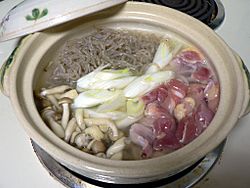Shirataki noodles facts for kids

Shirataki noodles (top) and other ingredients in a donabe
|
|
| Type | Japanese noodles |
|---|---|
| Place of origin | Japan |
| Main ingredients | Noodles (konjac yam) |
Shirataki are special Japanese noodles that look clear and a bit like jelly. They are made from a plant called the konjac yam. These noodles are a big part of traditional Japanese cooking.
Many people like shirataki noodles because they are very low in calories. They are also great for people who can't eat wheat, gluten, or eggs. This makes them a good choice for different diets and food needs.
Contents
What Are Shirataki Noodles Made Of?
Shirataki noodles come from the corm of the konjac yam. A corm is like a thick underground stem, similar to a bulb. This plant is also sometimes called "devil's tongue yam" or "elephant yam."
The name shirataki means "white waterfall" in Japanese. This describes how the noodles look, like thin white streams. Shirataki noodles are mostly water, about 97%. The other 3% is from the konjac plant. This part contains something called glucomannan, which is a type of dietary fiber that dissolves in water.
Because they have so much water and fiber, shirataki noodles have very few carbohydrates that your body can digest. They also have almost no food energy. This means they don't add many calories to your meal. They also have a very mild taste of their own.
How Are Shirataki Noodles Made?
In the past, people made shirataki noodles in different ways depending on where they lived in Japan. In the Kansai region, they would cut a jelly-like block of konnyaku into thin threads. They called these ito konnyaku.
In the Kantō region, they made the noodles differently. They would squeeze a liquid konjac mixture through tiny holes. This mixture would go into a hot, strong lime solution, which would turn it into noodles.
Today, most companies use the squeezing method to make both types of noodles. This way is more modern and efficient.
How to Use Shirataki Noodles in Cooking
You can find shirataki noodles in Asian markets and many supermarkets. They come in two main forms: dry or soft and "wet." The wet noodles are usually sold in a package with liquid. They can stay fresh for up to a year.
Sometimes, the liquid in the package can have a smell that some people don't like. If this happens, you can rinse the noodles well. You might also want to quickly cook them in hot water (parboil) or fry them (sauté) before adding them to your dish.
Another way to prepare them is to drain them and then dry-roast them. This means cooking them in a dry pan without oil. Dry-roasting can make them less bitter and give them a texture more like regular pasta. After dry-roasting, you can add them to soups, sauces, or noodle dishes.
Other Names for Shirataki Noodles
Shirataki noodles are also known by a few other names. These include ito-konnyaku, yam noodles, and devil's tongue noodles.
The form called ito konnyaku is usually thicker than regular shirataki. It also has a square shape and a darker color. This type is especially popular in the Kansai region of Japan.

